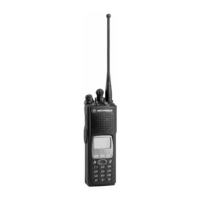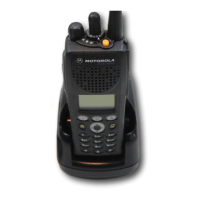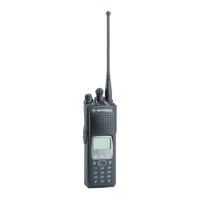July 16, 2004 6881094C28-D
3-4 Basic Theory of Operation: Digital (ASTRO) Mode of Operation
Transmitted signaling information is applied to the DSP from the microcontrol unit, where it is coded,
and passed to the DAC, which handles it the same as a voice signal. The DAC output connects to
the synthesizer modulation input. A modulated carrier is provided to the transmitter power amplifier,
which transmits the signal under dynamic power control.
3.3 Digital (ASTRO) Mode of Operation
In the ASTRO (digital) mode of operation, the transmitted or received signal is limited to a discrete
set of frequency deviation levels. The receiver handles an ASTRO-mode signal identically to an
analog-mode signal, up to the point where the DSP decodes the received data. In the ASTRO
receive mode, the DSP uses a different algorithm to recover data.
In the ASTRO transmit mode, microphone audio is processed identically to an analog mode, with the
exception of the algorithm the DSP uses to encode the information. Using this algorithm, transmitter
FM deviation is limited to discrete levels.
3.4 Transceiver Board
Refer to Figure 3-3, on page 3-3 and Figure 3-4, on page 3-3. The receiver front end consists of a
preselector filter, low-noise amplifier, a second preselector, and a mixer. Both preselectors are
varactor-tuned bandpass filters, controlled by the microcontroller. See Table 3-1 for local oscillator
(LO) and first IF information.
The frequency generation function is performed by three ICs, three discrete VCOs for 700–800 MHz
radios (two VCOs for VHF, four VCOs for UHF Range 1, and three VCOs for UHF Range 2), and
associated circuitry. The reference oscillator IC provides a frequency standard to the synthesizer.
The fractional-N synthesizer turns on one of three external VCOs for 700–800 MHz radios (two
external VCOs for VHF, or four for UHF Range 1, or three for UHF Range 2), and tunes it to the RX
LO or TX carrier frequency. The VCO buffer and a transistor, amplify the signal to the required power
level. The synthesizer is controlled by the microcontrol unit through a serial peripheral interface (SPI)
bus. Most of the synthesizer circuitry is enclosed in rigid metal cans on the transceiver board to
reduce interference and microphonic effects.
The receiver back end consists of a bandpass crystal filter, input and output impedance matching
networks, and the digital back-end IC. Final filtering is done digitally in the DSP.
The Abacus III digital back-end IC contains a low-noise amplifier, a mixer, a variable gain amplifier
with integral anti-alias filter, a bandpass, sigma delta, analog-to-digital converter, and a decimation
filter with a programmable decimation factor. The Abacus III also contains an automatic gain control
(AGC) circuit to provide 25 dB of continuous gain adjustments. For the second LO, the Abacus III
has an internal, integer-N frequency synthesizer, and an external, discrete loop filter and voltage-
controlled oscillator (VCO). The output of the Abacus III is digital data on the RX_SSI bus.
The transmitter power amplifier (PA) consists of a driver amplifier IC and a discrete final-stage.
Transmit power is controlled by a power control IC (PCIC) that monitors the output of a directional
coupler and adjusts PA control voltages. The transmitter RF signal then passes through a PIN diode
antenna switch and a low-pass harmonic filter, which connects to the antenna connector.
Table 3-1. Local Oscillator and First IF Frequencies
VHF UHF Range 1 UHF Range 2 700–800 MHz
LO Frequency Range 180.85–218.85 MHz 306.725–396.625 MHZ 376.65-446.65 MHZ 741.35–885.65 MHz
First IF Frequency 44.85 MHz 73.35 MHz 73.35 MHz 109.65 MHz

